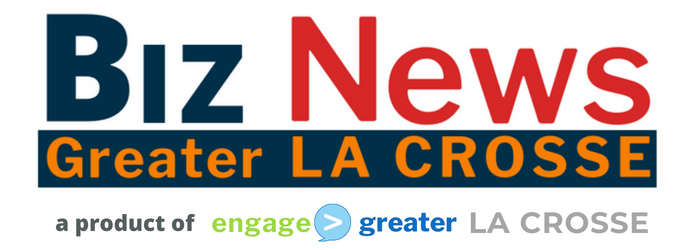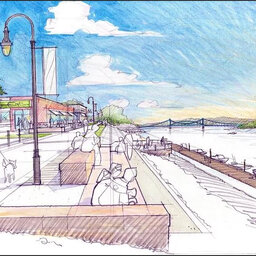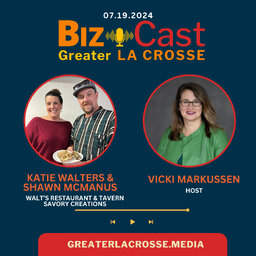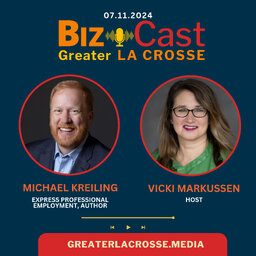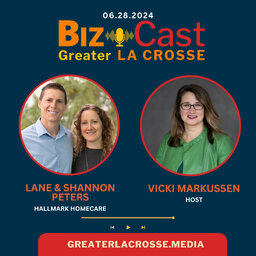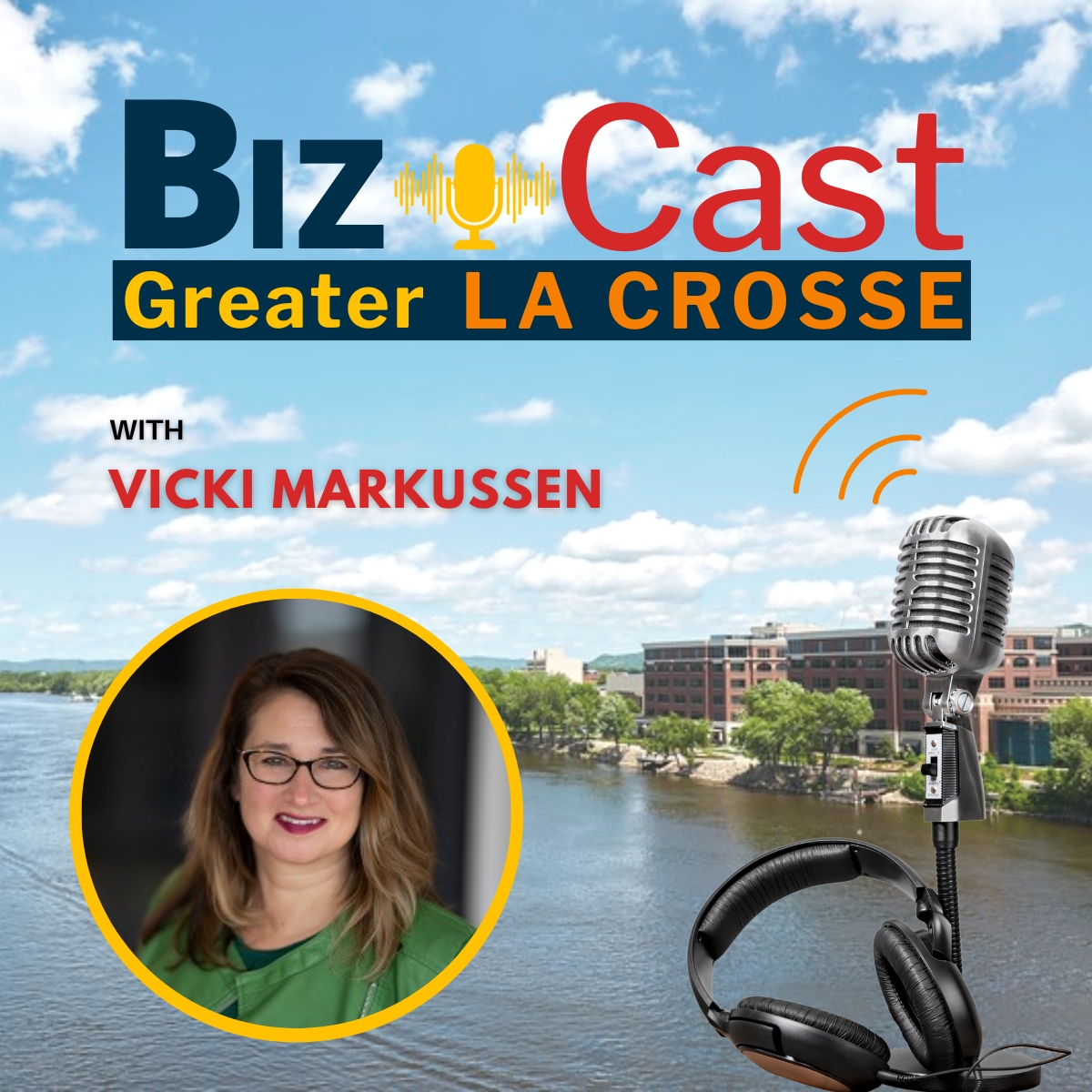
Episode 21
River Point District Moves Forward with Project Manager Jason Gilman
About BizCast Greater La Crosse
We bring you news from the business community. From startups to experienced problem solvers, you’ll get in-depth insight on the challenges and opportunities of doing business in Greater La Crosse. Our show is a collaboration between WIZMNews.com and BizNews Greater La Crosse ( GreaterLaCrosse.media ).
Full Transcript [ generated by AI]
BizCast 0019 Twinkle & Twine / ArtPOP
[00:00:00] That people get excited when they come in there and they laugh. And a woman came in the other day and said, I’m just gonna come here anytime. I’m feeling blue and I need a pick me up because this place makes me happy. And that, that to me is everything that I love to hear is that people come there because it is just darn fun.
[00:00:26] Welcome to Biz Cast. Greater Lacrosse. A weekly podcast from Biz News. We bring you news from the business community. I’m your host, Vicki Markussen, and joining me is Tracy Endrizzi. She is the owner of Art Pop and Twinkle and Twine, and it is still two separate businesses, correct? Not really. Okay. It is and it isn’t by name.
[00:00:47] They are, however, I have kind of pulled together the financial end of it together. We recently lost our business partner, which we are very sad about, and since then I’ve been trying to merge the two businesses. However, they distinctly stand apart as a gift shop and an art shop. And you are intentionally a.
[00:01:09] Small community gift shop. So for most people, describe where you are and the concept behind it. So we are on Market Street and when I tell people that if they haven’t been there, they’ll go, where are you? I go down Market Street all the time. Well, we’re about three doors down from Ranon. Little plug for Ranon there.
[00:01:28] Mm-hmm. It started off as a small mom and pop grocery store back in the 1920s, I think is when the building was built, and has been several things, mostly a grocery store. The most recently was Jim’s Barbers Shop and Dick Delphi’s Bowling Shop, and then I bought the place in 2016. So we’re talking about 16th and market, just around the corner, 15th and 16th.
[00:01:54] And so this building came up for sale. What made you say, I wanna buy that? I had always wanted to buy a building and my husband would look at me and say, no, no, no. And then this little corner place around, it was just around the corner from our house, and it was small, it was manageable. Quaint needed a little, little facelift, but it just spoke to him and it spoke to I as something that we could make work.
[00:02:20] I think the initial thought was a little hobby farm and that this was manageable. We loved the idea though, that it was plopped right in the middle of the neighborhood. Somehow Just having that community feel and building something that was a walkable, bikeable, community oriented business appealed to both of us.
[00:02:40] And did you have a concept for what that business would be? Initially I did not. I was homeschooling my daughter and I knew that I had a little bit of time left for that. And so I initially rented it out. And one of the first people I rented it out to started a little gift shop called Twinkling Twine Design.
[00:02:55] And Nicole started off on the small side of the shop. It was 150 square feet, just a tiny place. But after the year was up and my other tenant moved out, I knew that I was ready to start something and I knew I wanted it to be art oriented. I’ve always been interested in the arts. Dabbled with a lot of different types of art.
[00:03:14] And so when I spoke with Nicole about, you know, what she wanted to do, she wanted a bigger space. So she moved to the bigger size of the store, which at the time that place was cut in half. Mm-hmm. But she said, gosh, I’ve always wanted to do the art stuff as part of twinkle I twine. What if we, what if we started the art shop together?
[00:03:34] And then I just kept twinkle, I twine separate. And so that’s how we started off. Describe what Twinkle and Twine sells. Twinkle and Twine is kind of a fun little gift shop. It’s a little bit snarky, maybe a little sassy, but also has some really sweet and very practical gifts. I think it’s the type of gift shop you walk into and go, oh, What is this?
[00:03:56] I didn’t know I needed this. Mm-hmm. Oh, I know somebody who needs that. Mm-hmm. We do carry a lot of local artists as well, but it’s also a lot of retail that you wouldn’t necessarily go to Amazon to buy. Yes, it’s a great place to browse if you don’t know what to get someone walk through there. I also, and you know this cuz I’ve been in there, I think it’s a great place to go for like coaches gifts or thank you gifts because you have some local flair to it.
[00:04:25] We do have a lot of local flair. I do make a lot of. The coasters, we sell a ton of local coasters. Mm-hmm. Those we make in house. I do carry a lot of lacrosse specific stuff, but we also try to merchandise things that, gosh, end of school year teachers, we gotta have some teacher gifts.
[00:04:43] It’s Mother’s Day coming up. We’ve gotta have something interesting for mom. So we do try to pull in those particular events, but also give it a flare of local lacrosse. Right cuz you don’t want stagnant inventory. We’ll get into that in a second. Let’s finish with your timeline. So you have twinkle ENT twine, and then you open up art pop and explain.
[00:05:03] The first iteration of art pop. The first iteration was a kind of walk in do it yourself bar. We had these little cubbies and we would have ready, set to go projects. You could come in. In fact, I remember you coming in with your son. Mm-hmm. You could come in and we would have whatever on the menu for the month, and some of the things stayed there all the time, and then some things rotated in and out.
[00:05:26] We did a lot of things with plantings, with painting with. Gosh. Wood burning. What else? Glasses. Glasses. Etching of glasses. Mm-hmm. So it started off as kind of smaller projects things that were very doable by anybody. And you could just pull it right off the shelf. Yes. And then why did you change that model?
[00:05:49] Well, I think what we found is that both of us were more interested in doing a little bit more serious art. I started doing a lot more training. And pulling in some things that I used to do with glasswork, then also doing some jewelry and some glass enameling, and I just found that I liked doing things that were probably, I.
[00:06:11] A little one step up. Mm-hmm. Or more than one step up. So the more I learned, the more I was interested in offering some things that were different. I feel like some of the projects we had before are probably already offered in places here, downtown and other businesses. And so our goal is always to have unique projects that you don’t find elsewhere in town.
[00:06:34] There might be a few things that overlap, but. Typically, I think right now what we’re offering other people are not. Yes. So, which adds to the community something different that they can do? Yeah, it’s, I’m gonna say it in my words. So I look at it like, there’s some places you go for activity, it’s something fun to do.
[00:06:54] Yours is, I wanna create something unique that might make a great gift for someone that’s very personalized. It’s very customized. Like I know I’ve given my sister-in-law things that. Like it or not, I created for them. And and so it was a very unique gift though. They appreciated that there was time involved in it as opposed to just showing up and buying something.
[00:07:15] And that being said, we do those fun activities too because we do do the little group events and Yes. Most of our stuff is catered to smaller groups. I mean, we’ve done some larger group things, but because of the nature of some of the stuff we’re doing is, you know, sticking with parties that are 20 and under is more ideal.
[00:07:35] 20 people or age? 20. 20 people. Okay. we don’t really offer a lot for children under 10. Mm-hmm. Really? I mean, we’re at the point now where most of this stuff, we have signs all over our workshop that say, before you touch, know that everything is hot and sharp. Yes, yes. Beware, danger.
[00:07:54] And then you’ve, you continue to change the model. Correct. After that, Yes. So let’s see, where are we at in the timeline? So we still have, we started off with just the smaller area from that point on. Nicole and I had been working together about a year, and we said, this wall is really a pain in the patooty, so can we get rid of it?
[00:08:15] And so, mm-hmm. We decided that the wall was, that was, that was put up a long time ago to separate the barbershop and the bowling shop was not productive for us. And so we took that down. We expanded our art space into the back of the store, and so for a good two or three years we had. Both of them still combined with the idea being that we were going to change the experience, what we wanted the experience just to be is you could come in if you needed a little gift shop, and then, oh, by the way, gosh.
[00:08:46] We could do an art project here, or you come in for an art project and say, oh gosh, by the way, there’s some shopping here. And so they kind of went hand in hand very well together. We started expanding what we were offering in art projects, doing things that were a little bigger. Still not quite where we’re at now, but it.
[00:09:06] We could offer a lot more in that type of a space than what we had before. And by bigger, I’m guessing again, it’s just increasing the uniqueness of what’s being offered as well. Absolutely, absolutely not offered in the area. Absolutely. What happened next? We continued on like that for two years.
[00:09:26] I think our clientele started building up. I think we’ve started getting more notice at that point and repeat customers, folks that started having a little buzz about us being there. You know, we are kind of pushed back and in between all these houses, so I still to this day will get people come in and go.
[00:09:44] How long have you been here? I can’t believe I’ve never been in here. It’s always funny to me. I’m like, well, we’ve been here five years now. Yes. But even people that live in the neighborhood who are still finding us while, but Mark is. It’s fairly transitional to some degree. Mm-hmm. So we constantly have new people finding us and saying, oh my gosh, I’m so glad I found you.
[00:10:07] Mm-hmm. I’ll be back. And all of that was going very smoothly and, and very lovely. Meanwhile, my husband had picked up an art as well in the meantime which was not an easy art because he was having to travel. Back and forth to Minneapolis. He started glass blowing about five fish years ago. And the only place he could go was to Minneapolis to do any type of class time or training or classes.
[00:10:35] And so eventually he thought, gosh, when I retire I think I wanna do this, this would be fun and this would compliment what we have going on right now. And so he looked all around town for spaces he could put a glass blowing studio into, into, by the way. Yeah. Not a cheap venture. Mm-hmm. When I started my business, he was like, well, you’re gonna spend money on what?
[00:10:56] And then he started glassing and I’m like excuse me. Right. . Not the easiest thing to build a lot of infrastructure, and we wanted to make sure we did it right. And so we had worked with the city quite a long time to get the space approved to add on to our building. To be able to build a whole big workspace area that was properly ventilated, that was appropriately fireproofed and all that good stuff.
[00:11:25] And that finally happened during Covid actually. Hmm. The timing was kind of strange because we had had it all in the planning, and then who knew Covid would hit? It worked out great for us because we were shut down for a year. It gave us an opportunity to do that construction work and be able to not worry about how it was gonna affect the other business because we were already closed, as was everybody.
[00:11:46] Mm-hmm. And my contractor said as we finished up the project, thank goodness you did it now, because everything just increased three times in price, right. For construction. Right. But it, it worked out the best for us. We were finishing it up as Covid started lifting, we were just finishing up the final details.
[00:12:05] And initially it was just Joe’s place space until he was ready to commit to offering something. And in the past year, the. Other thing that happened was that my business partner, Sid, By the way, I just found out my husband got another job. Mm. We’re moving, which was not in the plans. So I think not for her.
[00:12:24] I think it was unexpected for her. I think obviously she probably knew longer than me but she really was the person who is responsible for making twinkling twine. What it was she taught me everything I know and what it is today is, is because of her influence all the things that she taught me.
[00:12:42] About what that business could be. When she first opened it, I said, oh, do you think these things will sell? And of course they do. And if you don’t know what I’m talking about, you should come in. Yes. So I do give her a lot of credit for making the store as successful as it is. And we knew that when she was moving away that the, the model for the art shop in the store has done so well that we wanted to continue that.
[00:13:08] Therefore I purchased twinkle intertwined from her and finished learning all the things really quickly that I needed to survive, which I don’t know that I still know them all, but we’re working on it. We find out every time something new comes up. Yeah. It was a big learning curve and it took me away from my concentration on art for a little while, but now everything I hope is starting to come back together and I’m figuring it all out.
[00:13:34] And how to, you know, my. My times are seasonal. Yeah. It sounds like you were learning a lot along the way, but retail is a whole other animal of inventory and what sells and doesn’t sell and the expense of that and pricing and
[00:13:51] things I. I did not know I would learn, but it, you know, again, in, in the different stages of your life and in the different stages of where you’re at. If I would’ve thought I would’ve been here 10 years ago, I would’ve said, no way. No way. I mean, this wasn’t just even anything I saw at that point. I enjoy challenge.
[00:14:12] I enjoy change. I enjoy the ups and downs of things. More, the ups than the downs, but it, keeps you on top of your game. And my kids are now getting older and it’s been fun to have something that I can put my energy into and something that I feel like I’ve helped create and can. Be proud of, and it probably helps that you had a gradual introduction.
[00:14:39] You had a partner there leading the way, right? Absolutely. Absolutely. And you know, the thing that is the hardest for me now that my business partner Nicole, has left, is that we collaborated so well on our projects and I still call her. I’m like, okay. Let’s talk this one through, but it’s not the same.
[00:14:56] It’s not the same as when you have someone that you really work well with that you can introduce an idea to. And they said, yes, but what if you did this? And I was like, oh, oh gosh. Next level we did that. Yeah, next level. So I, I do miss that type of collaboration. I hope to have some of that when my husband is full-time with the business as well, which hopefully will happen in, in the future here.
[00:15:21] What do you think that the average customer doesn’t realize about retail? I. Oh. Hmm. I think they don’t realize how little you make. Yeah. There’s hardly any profit margin. There’s, there’s not a large profit margin.
[00:15:34] I’ve heard it’s much larger in clothing. I don’t know because I’m not in clothing. What I would say is there’s not a big profit margin. You have to be smart about what you buy and where you buy it from and what your market will. We’ll sell at, you know, sometimes I go to bigger markets and they’ll say, but you can, you can charge this for it.
[00:15:54] And I said, not in lacrosse. You can’t. Lacrosse is a different market. We’re small. We also don’t wanna outprice ourselves. I also want people to be able to walk in and feel like we are inclusive to, to people buying things. You don’t wanna outprice yourself in the sense of you’re only gonna have a certain customer that can come in and afford to buy something.
[00:16:15] That challenge of finding that sweet spot and how do you do that? Is. It’s hard. That’s been a hard thing. It’s hard on the art side too though, and, and any artist will tell you, we are not paid for what we do. Not really. When you talk about how much training you’ve had to learn your skill, how much time that goes into making something, and then what your materials cost you for the most part.
[00:16:39] There’s a reason there’s, it’s called starving artists. You are not feeding your family on this food, not for your time. So you might be making some of your material money back, but a lot of times on your time, you better love what you do and I do. So I appreciate that. I have the opportunity to do these things and to make things.
[00:16:57] And you also, if in a way you’re, you’re not just doing art, you do have the retail side of it too. So they’re being complimentary. If it were just one I. That would be much more challenging. The financials would look different. My guess. They would look different. Also, it would look different from the perspective of, you know, I’d be out there like other artists doing these markets and doing, where can I sell at?
[00:17:21] Where can I bring my product to? Fortunately with the store, I’m able to kind of bring that stuff into the fold and they work really well together. Yeah, you had talked about the value of your time and in the end why you’re, why you’re doing this. You know, I am not doing this for the money.
[00:17:42] We will just say that. We still call it the hobby farm. It, it’s not to say you don’t make any money. Hmm. But I would say it, it can, it can float itself. I’m doing it because it’s really fun. I really enjoy what I’m doing right now, everything else I’ve done in life has been so far different from this.
[00:17:59] The idea that, that people get excited when they come in there and they laugh. And a woman came in the other day and said, I’m just gonna come here anytime I’m feeling blue and I need a pick me up because this place makes me happy. And that, that to me is everything that I love to hear is that people come there because it is just darn fun.
[00:18:21] Mm-hmm. Or funny. And you’re reminded of why you started, like you had told me you had read about Third Space and impact on community. Correct. So when we started off with this whole venture I did a lot of work with the city on, first of all, when I bought the building, I had to reestablish what it was used for because it’s in a neighborhood.
[00:18:42] And so it’s a different type of Districting. And so we had to tell them what we wanted to be and if that was okay. Which is important because we are in the middle of a bunch of neighborhood houses. And so you want those folks to love what you’re bringing to their neighborhood because it impacts.
[00:19:02] Their house, their neighborhood, their, their community. But there is a great book out there that talks about the third space there’s actually two different ones. One’s, one’s a little easier to read through, but they talk about how, The malls came to town and when certain, you know, the strip malls and the big malls and how everybody pulled these neighborhood businesses out and put in big grocery stores and they put in strip malls and all these places where if you wanted to go shopping, that’s where you went.
[00:19:34] You didn’t put this in your neighborhood and clutter up your neighborhood with these little tiny businesses. What they’ve since found, I think, is that crime has risen. Neighbors don’t know each other as well, because it used to be that when you walked home from work or got done with school, that you’d stop in, you’d get something at the grocery store, bring it on home, and you’d see your neighbors in there and you’d talk to them about what they’re doing.
[00:20:00] So I think what bigger cities are now finding, and hopefully we will find out just as well, is that when you start bringing these different community places back into the neighborhood, that you create more community. That people come in, they know each other, they build friendships, they find out, you know, about other people who are like them and like the things that they wanna do.
[00:20:20] And that to me has always been one of the top goals is to have this place where people go, oh, that little neighborhood place, it’s awesome. And it sounds like you have some examples of how you’ve seen that happen. Yeah. Last week, three women came in and they, they took a glass blowing class together and since then have gone out to eat and they’ve scheduled other classes and they ha they’re starting to build a friendship.
[00:20:45] And when I hear stories like that, and I know that’s happening, I feel like we’re doing something right. Absolutely. I think it’s been fun working with other small businesses too. Like I’m starting to find out, I think you recently spoke with.
[00:20:58] Without publishing. Like we’ve started to collaborate on a few things. Just, you know, that they found out we did some stuff that might be able to help them. And I, I think anytime now I’ve started working with these other businesses, you know, one of the things we do is the laser cutting.
[00:21:11] So I’ve had several people come in, worked with. Beer by bike brigade on certain projects they’ve had. And so the, the other aspect I really like is trading these ideas with these other small, local organizations where we can help each other out. I do have a lot of consignors and I do like to be able to, I don’t know, work with them and help them.
[00:21:33] It’s a different way of support just. Get creative minds together. Mm-hmm. Like it’s again, the community thing. It’s the, wow, you do this. That’s pretty cool. Like, You know, I could use some of that and yes, you could use some of this. Well, and owning a business requires some creativity and some people just think and approach it a different way.
[00:21:54] So when you, it’s similar to when you had a partner, it’s just, it’s, you raise things to the next level when you can engage others. Exactly. And I think what we always need to remember is being in business. Some people feel like they have to have their own thing going and be very competitive.
[00:22:13] I feel like I’m walking into this. The opposite is that there’s room for everybody. There’s room for what everybody does, and there’s room to celebrate what everybody does. And if we all remember that and. Work together that it does help make the community stronger, yeah. I don’t remember if she said it on the podcast, Emily Boland with Hunt Gather grazing boards, she said it will be really hard for a local business to fail in this community because the other local businesses just love to rally around each other and create this support network. And it just happens very organically, and I think that’s very unique for our community as well. It just makes everybody stronger.
[00:22:54] You have been listening to Biz Cast Greater Lacrosse. I am your host, Vicki Markussen. We’ll catch you next week.

